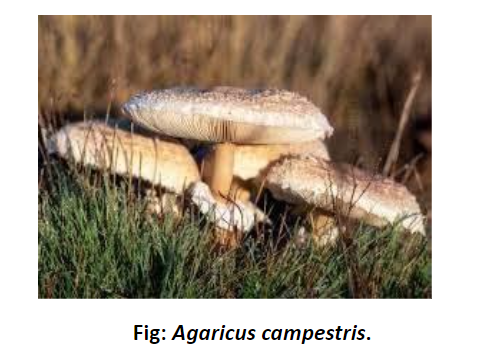
In basidiocarp of Agaricus campestris, each gill has -------
A. Two zones of monokaryotic hyphae
B. Three zones of monokaryotic and diploid hyphae
C. Three zones of dikaryotic hyphae
D. Two zones of dikaryotic and diploid hyphae
Answer
499.5k+ views
Hint: Basidiocarp is the fruiting body of a mushroom-producing fungus. The vegetative body of Agaricus is mycelial and consists of septate much-branched hyphae.
Complete answer:Spores on germination develop into monokaryotic or primary mycelium, either + or – type.
The primary mycelium is short-lived and it soon transforms into dikaryotic or secondary mycelium by the fusion of two cells of different monokaryotic mycelium (+ and -) following clamp connection. During germination, the two compatible hyphae merge to form dikaryotic mycelium but this structure is short-lived and becomes mononucleated.

Additional information: Agaricus is an edible fungus and is commonly known as mushroom. It is a saprophytic fungus found growing on soil humus, decaying litter, on damp forest floors, in the fields and lawns, wood logs, and manure piles.
1. Agaricus grows best in moist and shady places and is commonly seen during the rainy season. The mycelium of the Agaricus is subterranean.
2. Reproduction is of vegetative, asexual, and sexual type.
3. The mycelium has a tendency to grow in all directions from a central point to form a large invisible circular colony.
4. When the mycelium becomes mature at tips, sporophores are produced.
So, the answer is A. Two zones of monokaryotic hyphae.
Note: The sporophores appear in a circle. These circles of mushrooms are commonly called “fairy rings”, because of an old superstition that the mushroom growing in a ring indicates the path of dancing fairies.
Complete answer:Spores on germination develop into monokaryotic or primary mycelium, either + or – type.
The primary mycelium is short-lived and it soon transforms into dikaryotic or secondary mycelium by the fusion of two cells of different monokaryotic mycelium (+ and -) following clamp connection. During germination, the two compatible hyphae merge to form dikaryotic mycelium but this structure is short-lived and becomes mononucleated.

Additional information: Agaricus is an edible fungus and is commonly known as mushroom. It is a saprophytic fungus found growing on soil humus, decaying litter, on damp forest floors, in the fields and lawns, wood logs, and manure piles.
1. Agaricus grows best in moist and shady places and is commonly seen during the rainy season. The mycelium of the Agaricus is subterranean.
2. Reproduction is of vegetative, asexual, and sexual type.
3. The mycelium has a tendency to grow in all directions from a central point to form a large invisible circular colony.
4. When the mycelium becomes mature at tips, sporophores are produced.
So, the answer is A. Two zones of monokaryotic hyphae.
Note: The sporophores appear in a circle. These circles of mushrooms are commonly called “fairy rings”, because of an old superstition that the mushroom growing in a ring indicates the path of dancing fairies.
Recently Updated Pages
Master Class 10 Science: Engaging Questions & Answers for Success

Master Class 10 Social Science: Engaging Questions & Answers for Success

Master Class 10 Maths: Engaging Questions & Answers for Success

Master Class 10 English: Engaging Questions & Answers for Success

Class 10 Question and Answer - Your Ultimate Solutions Guide

Master Class 9 General Knowledge: Engaging Questions & Answers for Success

Trending doubts
Give 10 examples of unisexual and bisexual flowers

Draw a labelled sketch of the human eye class 12 physics CBSE

Differentiate between homogeneous and heterogeneous class 12 chemistry CBSE

Differentiate between insitu conservation and exsitu class 12 biology CBSE

What are the major means of transport Explain each class 12 social science CBSE

What is the difference between resemblance and sem class 12 social science CBSE




